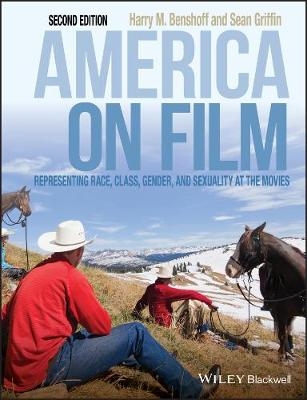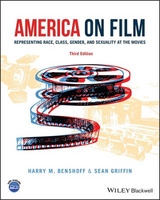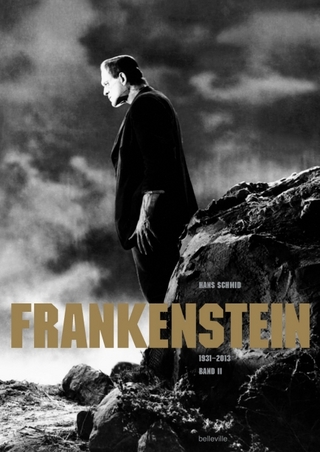
America on Film
Wiley-Blackwell (an imprint of John Wiley & Sons Ltd) (Verlag)
978-1-4051-7055-0 (ISBN)
- Titel erscheint in neuer Auflage
- Artikel merken
America on Film: Representing Race, Class, Gender, and Sexuality in the Movies, 2nd Edition is a lively introduction to issues of diversity as represented within the American cinema. Provides a comprehensive overview of the industrial, socio-cultural, and aesthetic factors that contribute to cinematic representations of race, class, gender, and sexuality Includes over 100 illustrations, glossary of key terms, questions for discussion, and lists for further reading/viewing Includes new case studies of a number of films, including Crash, Brokeback Mountain, and Quinceanera
Sean Griffin is Associate Professor of Cinema and Television at Southern Methodist University. Harry M. Benshoff is Associate Professor of Radio, Television, and Film at the University of North Texas.
Acknowledgments. How to Use This Book. Part I: Culture and American Film: . 1. Introduction to the Study of Film Form and Representation . Film Form. American Ideologies: Discrimination and Resistance. Culture and Cultural Studies. Case Study: The Lion King (1994). Questions for Discussion. Further Reading. 2. The Structure and History of Hollywood Filmmaking . Hollywood vs. Independent Film. The Style of Hollywood Cinema. The Business of Hollywood. The History of Hollywood: The Movies Begin. The Classical Hollywood Cinema. World War II and Postwar Film. 'New' Hollywood and the Blockbuster Mentality. Questions for Discussion. Further Reading. Further Screening. Part II: Race and Ethnicity and American Film: . Introduction to Part II: What is Race?. 3. The Concept of Whiteness and American Film. Seeing White. Bleaching the Green: The Irish in American Cinema. Looking for Respect: Italians in American Cinema. A Special Case: Jews and Hollywood. Case Study: The Jazz Singer (1927). Veiled and Reviled: Arabs on Film in America. Conclusion: Whiteness and American Film Today. Questions for Discussion. Further Reading. Further Screening. 4. African Americans and American Film. African Americans in Early Film. Blacks in Classical Hollywood Cinema. World War II and the Postwar Social Problem Film. The Rise and Fall of Blaxploitation Filmmaking. Box: Blacks on TV. Hollywood in the 1980s and the Arrival of Spike Lee. Black Independent vs. "Neo-Blaxploitation" Filmmaking. New Images for a New Century - Or Not?. Case Study: Bamboozled (2000). Questions for Discussion. Further Reading. Further Screening. 5. Native Americans and American Film. The American "Indian" Before Film. Ethnographic Films and the Rise of the Hollywood Western. The Evolving Western. A Kinder, Gentler America?. Case Study: Smoke Signals (1998). Conclusion: Twenty-First-Century Indians?. Questions for Discussion. Further Reading. Further Screening. 6. Asian Americans and American Film. Silent Film and Asian Images. Asians in Classical Hollywood Cinema. World War II and After: War Films, Miscegenation Melodramas, and Kung Fu. Contemporary Asian American Actors and Filmmakers. Case Study: Eat a Bowl of Tea (1989). Questions for Discussion. Further Reading. Further Screening. 7. Latinos and American Film. The Greaser and the Latin Lover: Alternating Stereotypes. World War II and After: The Good Neighbor Policy. The 1950s to the 1970s: Back to Business as Usual?. Expanding Opportunities in Recent Decades. Conclusion: A Backlash Against Chicanos?. Case Study: My Family/Mi Familia (1995). Questions for Discussion. Further Reading. Further Screening. Part III: Class and American Film: . Introduction to Part III: What is Class?. 8. Classical Hollywood Cinema and Class. Setting the Stage: The Industrial Revolution. Early Cinema: The Rise of the Horatio Alger Myth. Hollywood and Unionization. Class in the Classical Hollywood Cinema. Case Study: The Grapes of Wrath (1940). Conclusion: Recloaking Class Consciousness. Questions for Discussion. Further Reading. Further Screening. 9. Cinematic Class Struggle After the Depression. From World War II to the Red Scare. From Opulence to Counterculture. Box: Class on Television. New Hollywood and the Resurrection of the Horatio Alger Myth. Case Study: Bulworth (1998). Conclusion: Corporate Hollywood and Labor Today. Questions for Discussion. Further Reading. Further Screening. Part IV: Gender and American Film: . Introduction to Part IV: What is Gender?. 10. Women in Classical Hollywood Filmmaking. Images of Women in Early Cinema. Early Female Filmmakers. Images of Women in 1930s Classical Hollywood. World War II and After. Case Study: All that Heaven Allows (1955). Questions for Discussion. Further Reading. Further Screening. 11. Exploring the Visual Parameters of Women in Film . Ways of Seeing. "Visual Pleasure and Narrative Cinema". Case Study: Gilda (1946). Conclusion: Complicating Mulvey's Arguments. Questions for Discussion. Further Reading. Further Screening. 12. Masculinity in Classical Hollywood Filmmaking. Masculinity and Early Cinema. Masculinity and the Male Movie Star. World War II and Film Noir. Case Study: Dead Reckoning (1947). Masculinity in 1950s American Film. Questions for Discussion. Further Reading. Further Screening. 13. Gender in American Film Since the 1960s. Second Wave Feminism and Hollywood. Box: Women and American Television. Into the 1980s: A Backlash against Women?. A New Generation of Female Filmmakers. Case Study: The Ballad of Little Jo (1993). Conclusion: Gender in the Early Twenty-First Century. Questions for Discussion. Further Reading. Further Screening. Part V: Sexuality and American Film:. Introduction to Part V: What is Sexuality?. 14. Heterosexuality, Homosexuality, and Classical Hollywood. (Hetero)Sexuality on Screen. (Homo)Sexuality in Early Film. Censoring Sexuality during the Classical Hollywood Era. Postwar Sexualities and the Weakening of the Production Code. Camp and the Underground Cinema. Case Study: The Celluloid Closet (1995). Questions for Discussion. Further Reading. Further Screening. 15. Sexualities on Film Since the Sexual Revolution. Hollywood and the Sexual Revolution. Film and Gay Culture from Stonewall to AIDS. The AIDS Crisis. Box: Queer TV. Queer Theory and New Queer Cinema. Case Study: Go Fish (1995). Hollywood Responds to New Queer Cinema. (Hetero)Sexualities in Contemporary American Cinema. Questions for Discussion. Further Reading. Further Screening. Part VI: Ability and American Film:. Introduction to Part VI: What is Ability?. 16. Cinematic Images of (Dis)Ability. Disabled People in Early American Film: Curiosities and Freaks. Romanticizing Disability in Classical Hollywood Melodramas. Disability in War Movies and Social Problem Films. Disability and the Counterculture. Case Study: Children of a Lesser God (1986). A More Enlightened Age?. Questions for Discussion. Further Reading. Further Screening. 17. Making Connections . Case Study 1: Queen Christina (1933). Case Study 2: The Old Maid (1939). Case Study 3: The Gang's All Here (1943). Case Study 4: A Patch of Blue (1965). Case Study 5: Erin Brockovich (2000). Case Study 6: 8 Mile (2002). Case Study 7: Better Luck Tomorrow (2002). Case Study 8: Saving Face (2004). Case Study 9: Crash (2004). Case Study 10: The Prize Winner of Defiance, Ohio (2005). Case Study 11: Brokeback Mountain (2005). Case Study 12: Quinceanera (2006). Glossary. Index
| Erscheint lt. Verlag | 2.1.2009 |
|---|---|
| Verlagsort | Chicester |
| Sprache | englisch |
| Maße | 190 x 243 mm |
| Gewicht | 998 g |
| Themenwelt | Kunst / Musik / Theater ► Film / TV |
| Sozialwissenschaften ► Kommunikation / Medien | |
| ISBN-10 | 1-4051-7055-7 / 1405170557 |
| ISBN-13 | 978-1-4051-7055-0 / 9781405170550 |
| Zustand | Neuware |
| Informationen gemäß Produktsicherheitsverordnung (GPSR) | |
| Haben Sie eine Frage zum Produkt? |
aus dem Bereich



